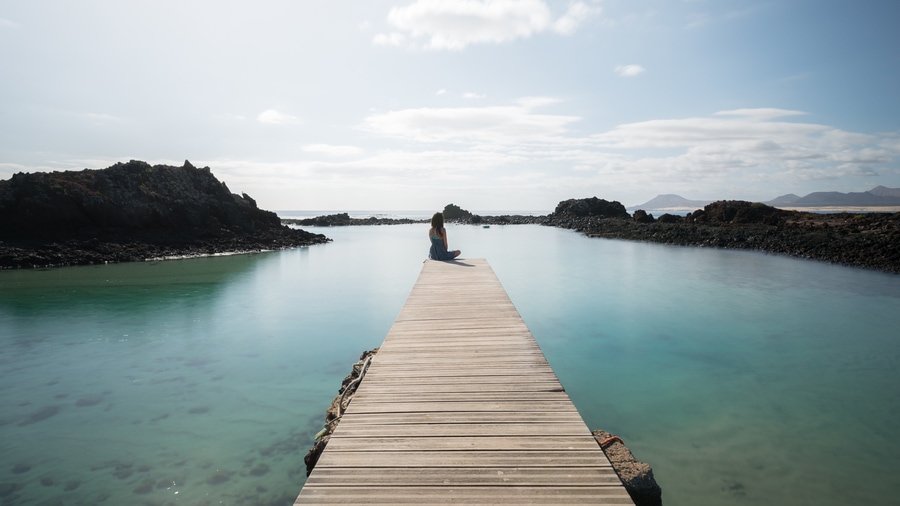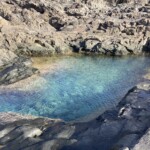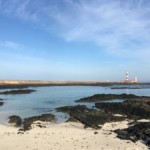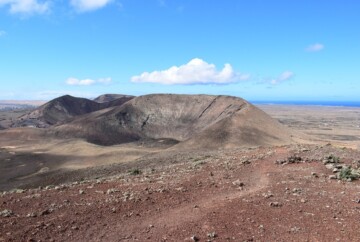While the beaches take center stage, Fuerteventura’s lagoons and natural pools are also spectacular. The coastal waters can be choppy, but the natural rock pools offer a calmer alternative perfect for children or not-so-strong swimmers.
Besides, these lagoons are scattered across the island, usually close to the most popular attractions in Fuerteventura, so you don’t have to go out of your way to enjoy them. Of course, there are also a few hidden gems that will allow you to enjoy some tranquility away from the tourist crowds.
I’ll tell you all about them in this guide to the best natural pools in Fuerteventura, which includes a convenient map to help you find each one. So, are you ready to discover the unique charm of these natural rock pools?
1. Aguas Verdes, the best natural pools in Fuerteventura
First, Aguas Verdes is one lagoon in Fuerteventura that you can’t miss. It’s one of the most popular natural pools on the island, located just a few feet from Playa del Valle, one of the best places to visit in Betancuria.
This area is known for its calm waters, but you can do other things here besides swimming. The lagoon is surrounded by beautiful hiking trails leading to some incredible viewpoints overlooking Betancuria Rural Park, so I recommend dedicating some time to exploring this one-of-a-kind place.

1. Aguas Verdes, the best natural pools in Fuerteventura
Before heading to this natural pool in Fuerteventura, make sure the tide is low. Otherwise, it can get dangerous when the tide starts rising, eventually submerging the entire pool. Given the limited window of time for swimming, this lagoon gets pretty crowded, so if you’re looking for something more remote, check out one of the other options below.
I will say that coming here at sunset is well worth it since the views are spectacular, and you can admire the golden glow of sunset while enjoying a relaxing dip in the water. If you bring goggles, you can take a peek at the spider crabs, starfish, and colorful fish below the water’s surface.
2. Charcones de Ajuy, the perfect lagoon in Fuerteventura for adventurers
The Charcones de Ajuy are a series of “charcones” or natural pools in Fuerteventura made of volcanic stone. Over time, the strong sea waves have eroded the terrain, creating cliffs, underground caves, and impressive rock formations.
The lagoons are along the coast of Ajuy, one of the best towns in Fuerteventura that’s worth exploring on its own. For example, the surrounding black sand beaches starkly contrast the turquoise blue waters. I recommend going to Ajuy Beach, which is known as one of the top beaches in Fuerteventura.

2. Charcones de Ajuy, the perfect lagoon in Fuerteventura for adventurers
You’ll want to bring water shoes to this natural rock pool in Fuerteventura since the bottom is covered in sharp rocks that can hurt your feet. Also, avoid swimming at high tide, which can be dangerous. When the tide is low, you can enjoy the serene environment and float in the water while being protected from the strong ocean waves.
Swimming in this lagoon is a great way to relax after exploring one of the nearby hiking routes in Fuerteventura, such as the route to the famous Ajuy Caves. These caverns are beautiful and hold immense historical and cultural value, not to mention some intriguing legends! We learned all about them on this tour, which I highly recommend.
3. Caleta de Fuste natural pool, an easily accessible lagoon in Fuerteventura
The natural pool in Caleta de Fuste, Fuerteventura, is the perfect place to go as a family, thanks to its easy accessibility.
You can get to this lagoon by foot or car, starting at Playa del Castillo, one of the top attractions in Caleta de Fuste. If you’re up for a nice walk, you can leave your car in the parking lot by the beach and take the rock path along the coast, which offers lovely ocean views.

3. Caleta de Fuste natural pool, an easily accessible lagoon in Fuerteventura
The rock pool itself is open year-round and has clear turquoise waters that draw quite a crowd. It gets pretty busy during the day, so if you want to avoid all the hustle and bustle, I recommend visiting early in the morning.
Also, keep in mind that there aren’t any shops or restaurants in the area, so I suggest packing a lunch and any other necessities you’ll need for a day at the beach.
4. Laguna de Playa Barca, one of the most famous natural pools in Fuerteventura
The Laguna de Playa Barca is another well-known natural pool in Fuerteventura and one of the most popular attractions on the Jandía Peninsula. As the name suggests, it’s on Playa Barca, one of the beaches that make up Sotavento Beach. So, you can take advantage of visiting a beautiful lagoon while seeing one of the top-rated beaches in Jandía.
You can only see this lagoon during low tide, when the ocean waters get trapped between the sand banks of the coast, creating picturesque rock pools. Each lagoon boasts a distinct shade of turquoise, thanks to the different depths of the sand dunes surrounding it.

4. Laguna de Playa Barca, one of the most famous natural pools in Fuerteventura
Another way to see these natural pools is by climbing up to the Mirador del Salmo or Mirador de Sotavento. Perched atop the nearby cliffs, they provide panoramic views of the entire coast.
In addition to splashing around in the lagoons, there are several interesting excursions in Fuerteventura that depart from here. And if you’re a fan of watersports, the World Windsurfing & Kiteboarding Championship takes place here every year. Just be prepared for lots of tourists and busy crowds!
5. Lagos del Cotillo, Fuerteventura’s wild natural pools
The Lagos del Cotillo are a group of natural pools in Fuerteventura located in the fishing village of El Cotillo. This town is a prime destination for experiencing the island’s traditional culture, including an authentic Canarian meal at one of Fuerteventura’s best restaurants.
As for the lagoons, their exquisite blue-green color stands out against the white sand and black volcanic rocks. Paired with the village’s calm atmosphere, these lagoons in Fuerteventura are ideal for a relaxing and leisurely visit.

5. Lagos del Cotillo, Fuerteventura’s wild natural pools
Near the Lagos del Cotillo, you’ll find other beaches with crystal-clear waters that are perfect for a refreshing swim or water sports like snorkeling and paddle surfing. Of course, the fine white sands are also an inviting spot to just lay out and sunbathe.
Finally, these lagoons are pretty close to town, so they’re among the more popular natural rock pools in Fuerteventura. You’ll probably run into other people there, but I’m sure you’ll still have a wonderful time.
6. El Puertito natural pool, a heavenly lagoon on Isla de Lobos, Fuerteventura
The next lagoon in Fuerteventura that I recommend is off the mainland, so it requires a bit of planning to visit. To get to El Puertito Natural Pool, you must go to the port of Corralejo and take a ferry to Isla de Lobos, a small island off the coast.
The boat ride takes just 20 minutes, but keep in mind that you need a permit to disembark on Isla de Lobos. The permit grants you 4 hours to explore the island, which is more than enough time to swim in the natural pool and discover the islet’s other attractions.

6. El Puertito natural pool, a heavenly lagoon on Isla de Lobos, Fuerteventura
Best of all, El Puertito is right next to the dock where the ferry drops you off. You’ll see a series of natural rock pools with clear turquoise waters, surrounded by beautiful scenery. In fact, Lobos Island is still largely untouched, so it boasts a pristine environment with diverse marine life. So, bring your goggles!
If you get hungry after swimming at El Puertito, you’re in luck. The island’s only restaurant is right next door, so you can enjoy a delicious lunch by the sea.
7. Playa de Los Charcos natural pools in Fuerteventura
Finally, Playa de Los Charcos has several must-see natural lagoons in El Cotillo. They’re located about 2.5 miles from the town center, right by Playa de Los Charcos, one of the most famous beaches in El Cotillo.
These lagoons dot the entire coast, but you can only see them during low tide when the sea water gets trapped between the lava rocks. These are my favorite natural pools in Fuerteventura because the color of the water is magnificent and contrasts so beautifully with the dark rock formations. I was captivated the first time I saw them, and I’m sure you will be, too!

7. Playa de Los Charcos natural pools in Fuerteventura
To get there, you’ll have to drive from El Cotillo, then take a short walk between the rocks. I highly recommend wearing water shoes to protect your feet.
In addition to swimming in the turquoise lagoons, you can go to the Tostón Lighthouse, which is home to the Traditional Fishing Museum. It’s a little over half a mile away, so you can fit it into your visit. Also, if you have a snorkeling mask or goggles, you can see all the marine life that lives in the natural pools.
That’s it from me! I hope you discovered some natural pools in Fuerteventura that you’d like to visit. Here is a map with each lagoon I mentioned, so you can quickly locate the ones you want on your itinerary:
If you have any questions or you’d like to share a lagoon in Fuerteventura that I missed, leave a comment below. I’d love to hear from you!
Enjoy your trip to Fuerteventura!

















